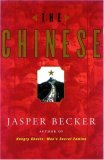Summary | Excerpt | Reviews | Readalikes | Genres & Themes | Author Bio

Critics' Opinion:
Readers' Opinion:
First Published:
Dec 2000, 304 pages
Paperback:
Feb 2002, 493 pages
In the mountainous provinces of Fujian, Guangdong, Guangxi, Guizhou and Yunnan, Han Chinese now dominate the towns in the valleys and the delta regions, while what are called ethnic minorities -- races such as the Miao (Hmong), the Dai (Thai) and the Zhuang -- tend to live in the mountains and are still considered poor and backward. Some emigrants from northern China, known as Hakka or guest people, still retain a separate identity, culture and language in the south.
Current research into the genetic make-up of the population of China has concluded that the populations of northern and southern China are quite distinct and that, genetically, northern Chinese are closer to Caucasians than they are to southern Chinese. The difference also emerges in language. Dialects such as Cantonese might equally well be classified as separate languages for they are incomprehensible to northern Chinese. Modern standard Chinese is based on the Chinese spoken in Beijing, supposedly that used by imperial court officials or Mandarins.
The imperial tradition held that the peoples of conquered territories voluntarily submitted to absorption within the empire and to the adoption of the culture and language of their rulers. Whatever language or dialect was spoken, all were required to write using the same standard Chinese characters. This sinification policy continues today: great efforts are made to ensure that schoolchildren, whatever their race, are taught in standard Chinese.
More distant regions of south-east Asia, despite being repeatedly invaded by Chinese armies, including those of the Mongols and the Manchus, remained outside the empire. Countries such as Vietnam, Laos, Burma, Cambodia and Thailand retained their separate identities but operated within China's sphere of influence, submitting tribute and copying some Chinese institutions. In more recent years, these countries have also been settled by Han Chinese migrants trying to escape the restrictions of first imperial and then Communist China. In the north, Korea too was repeatedly annexed, most recently by the Manchus, but retained its independence and monarchy.
The principal danger to China has always come from the north and the north-west, and to stabilize these regions successive dynasties either attempted forced settlement to colonize them or built walls to keep out their indigenous inhabitants. The First Emperor built the Great Wall to keep his subjects in and keep the nomads of the steppes out. However, the biggest period of wall building took place during the Ming dynasty (1368-1644) whose rulers largely rejected any notions of 'peaceful coexistence' with the barbarian tribes in the northern grasslands. In other periods attempts were made to colonize the Gansu corridor, through which successive waves of invaders entered China, and the provinces of what are now Qinghai and Xinjiang.
In 1644, Manchu nomads crossed the Great Wall from Manchuria and established the Qing dynasty, a highly authoritarian, neo-Confucian regime. Although they expelled all Chinese from Manchuria, their legacy is the addition of territories that are now the three northernmost provinces of China -- Liaoning, Jilin and Heilongjiang. However, large-scale exploitation and settlement of these regions only took place in the final decades of the Qing dynasty with the advent of the railway.
Various Mongol tribes were junior partners in the conquest of China, and Mongolian lands fell under the domination of the Manchu court. Although, as with Manchuria, Chinese settlement of Mongolia was forbidden until the end of the nineteenth century, Mongol chieftains regarded themselves as vassals of the Manchu emperor. The dispatch of Manchu armies to Xinjiang also ensured the loyalty of the western Mongols, and Tibet fell under the sway of the Emperor when Manchu forces crossed the vast Tibetan plateau in the late eighteenth century.
Copyright © 2001 by Jasper Becker.





The Flower Sisters
by Michelle Collins Anderson
From the new Fannie Flagg of the Ozarks, a richly-woven story of family, forgiveness, and reinvention.

The House on Biscayne Bay
by Chanel Cleeton
As death stalks a gothic mansion in Miami, the lives of two women intertwine as the past and present collide.

The Funeral Cryer by Wenyan Lu
Debut novelist Wenyan Lu brings us this witty yet profound story about one woman's midlife reawakening in contemporary rural China.
Your guide toexceptional books
BookBrowse seeks out and recommends the best in contemporary fiction and nonfiction—books that not only engage and entertain but also deepen our understanding of ourselves and the world around us.